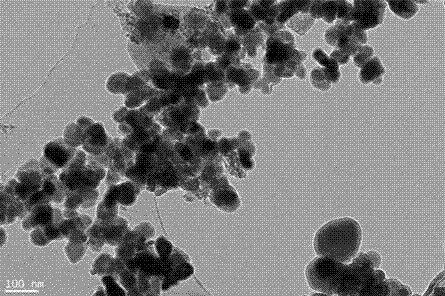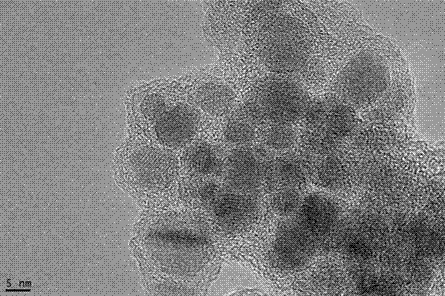Low-temperature oxidation preparation method of different carbon-coated nanocrystallines
A nanocrystalline, carbon-coated technology, applied in nanotechnology, nanotechnology, nanotechnology for materials and surface science, etc., can solve problems such as inability to promote industrialization, high precursor toxicity, and complex processes
- Summary
- Abstract
- Description
- Claims
- Application Information
AI Technical Summary
Problems solved by technology
Method used
Image
Examples
Embodiment 1
[0029] Evenly mix 4.65 grams of ferrocene and 12.6 grams of ammonium dichromate, put them into a pressure-dissolving bomb with a volume of 200 milliliters of polytetrafluoroethylene lining, and lock and seal. Heat the pressure melting bomb to 200°C, keep it warm for 1 hour and then cool to room temperature. The obtained black powder was washed with concentrated hydrochloric acid, deionized water and absolute ethanol, and dried to obtain 3.4 g of carbon-coated equiaxed Fe 3 o 4 Nanocrystalline. The carbon-coated equiaxed Fe 3 o 4 The transmission electron microscope photographs of the nanocrystals are as figure 1 As shown, Fe 3 o 4 The nanocrystal is equiaxed, the grain size is concentrated in the range of 20-90nm, the median diameter is 53nm, and the thickness of the carbon shell coated on the surface of the nanocrystal is about 5nm.
Embodiment 2
[0031] Evenly mix 6.1 g of cyclooctatetraenetricarbonyl iron with 11.4 g of ammonium persulfate, put it into a pressure-dissolving bomb with a volume of 200 ml of Teflon lining, and lock and seal it. Heat the pressure melting bomb to 200°C, keep it warm for 1 hour and then cool to room temperature. The obtained black powder was cleaned and dried with deionized water and absolute ethanol to obtain 3.9 g of carbon-coated spherical Fe 3 o 4 Nanocrystalline. The carbon-coated spherical Fe 3 o 4 The transmission electron microscope pictures of the nanocrystals are as figure 2 As shown, Fe 3 o 4 The nanocrystal is spherical, the grain size is concentrated in the range of 5-40nm, the median diameter is 15nm, and the thickness of the carbon shell covered on the surface of the nanocrystal is about 2-5nm.
Embodiment 3
[0033] Evenly mix 4.65 grams of ferrocene, 11.4 grams of ammonium persulfate and 2 grams of sodium chloride, put them into a 200 milliliter polytetrafluoroethylene-lined pressure melt bomb and lock and seal. Heat the pressure melting bomb to 200°C, keep it warm for 1 hour and then cool to room temperature. The obtained black powder was washed with deionized water and absolute ethanol, and dried to obtain 4.1 g of carbon-coated rod-shaped Fe 7 S 8 Nanocrystalline.
PUM
| Property | Measurement | Unit |
|---|---|---|
| particle diameter | aaaaa | aaaaa |
| thickness | aaaaa | aaaaa |
| size | aaaaa | aaaaa |
Abstract
Description
Claims
Application Information
 Login to view more
Login to view more - R&D Engineer
- R&D Manager
- IP Professional
- Industry Leading Data Capabilities
- Powerful AI technology
- Patent DNA Extraction
Browse by: Latest US Patents, China's latest patents, Technical Efficacy Thesaurus, Application Domain, Technology Topic.
© 2024 PatSnap. All rights reserved.Legal|Privacy policy|Modern Slavery Act Transparency Statement|Sitemap



